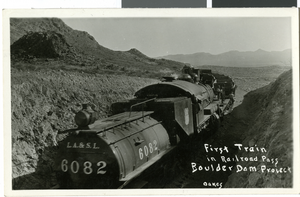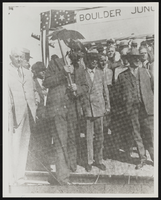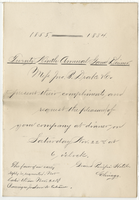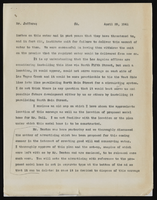Search the Special Collections and Archives Portal
Search Results

Postcard of a Union Pacific Railroad train, during Hoover Dam construction, late 1920s - early 1930s
Date
1925 to 1935
Archival Collection
Description
A Union Pacific Railroad train as a part of the construction for Hoover Dam. The front of the card reads: "First train in railroad pass, Boulder Dam Project, Oakes." Description given with postcard: "SP, LA & SL (UPRR) locomotive 6082 in Railroad Pass. Maybe spreading ballast on track."
Image

Photograph of six men at the signing of the Boulder Dam Bill, December 21, 1928
Date
1928-12-21
Archival Collection
Description
Left to right shown are: Elwood Mead, Comm. Of Reclamation; Phil Swing, author of the bill, a member of House of Representatives from California; President Coolidge; U.S. senator Hiram Johnson, another author of the boulder Dam bill; Addison T. Smith, Chairman, Committee on Reclamation, House of Representatives; W.B. Matthews, General Counsel, Boulder Dam Association, Los Angeles, California. The occasion is the signing of the Boulder Dam bill, Dec. 21, 1928.
Image

Dr. Ray Lyman Wilbur, United States Secretary of the Interior: photographic print
Date
1910 (year approximate) to 1945 (year approximate)
Archival Collection
Description
From the Elizabeth Harrington Photograph Collection (PH-00291). Inscription with image reads: "Driving the silver spike. Dr. Ray Lyman Wilbur, Secretary of the Interior, drives the last spike into tracks of railroads spur to the damsite. To the right of Dr. Wilbur is Senator Key Pittman. Nest to Pittman is Nevada Governor Fred Balzar. Second back from Senator Pittman is Las Vegas Mayor Fred Hesse. To the left of Dr. Wilbur is Carl R. Coray, Union Pacific Railroad president." - E(lizabeth) Harrington.
Image

Invitation for the Twenty-ninth annual game dinner, Saturday, November 22, 1884, Grand Pacific Hotel
Date
1884-11-22
Archival Collection
Description
Note: Handwritten invitation Restaurant: The Grand Pacific Hotel Location: Chicago, Illinois, United States
Text
Pagination
Refine my results
Content Type
Creator or Contributor
Subject
Archival Collection
Digital Project
Resource Type
Year
Material Type
Place
Language
Records Classification






